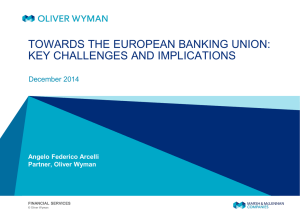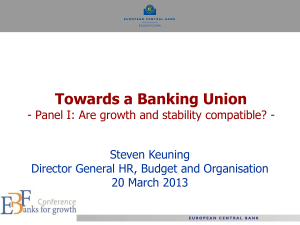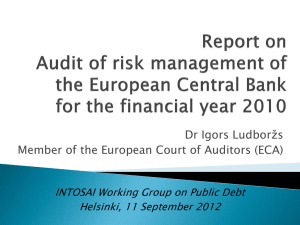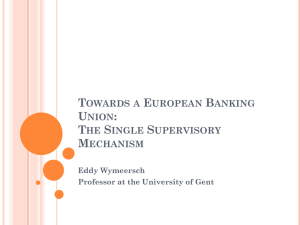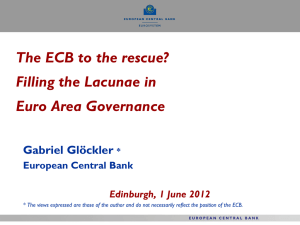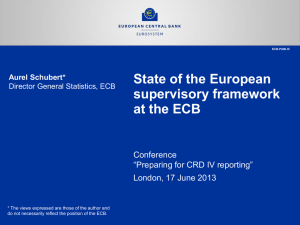ECB
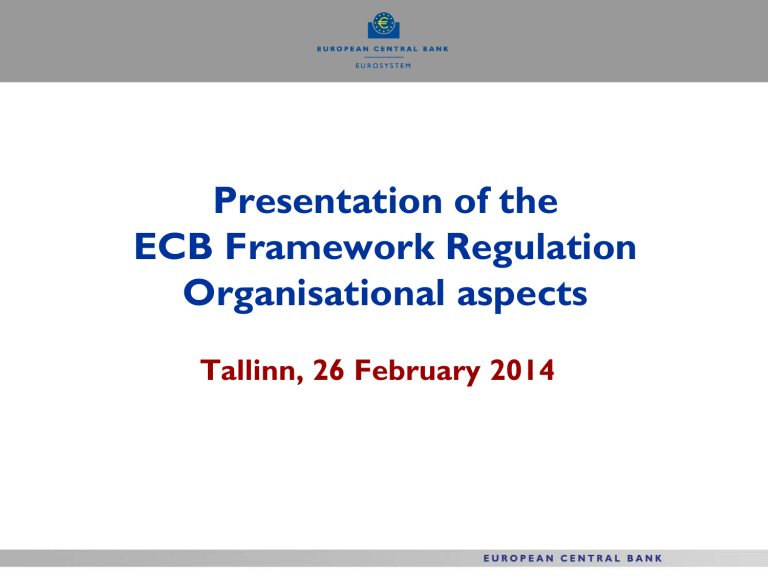
Presentation of the
ECB Framework Regulation
Organisational aspects
Tallinn, 26 February 2014
Timeline
SSM
Regulation enters into force
Submission to the
European
Parliament
Public hearing Publication on the ECB’s website
SSM takes over banking supervision
3 Nov. 2013
30 Jan. 2014
4 Feb.
7 Feb.
19 Feb.
7 March by 4 May
May
4 Nov.
End of public consultation
Publication in
Official Journal
Supervisory Board endorses draft
Framework Regulation at its first meeting
Launch of public consultation
2
Legal basis
Articles 6 and
33(1) SSMR
ECB shall adopt and make public (by 4 May 2014) a framework to organise the practical arrangements for the implementation of the cooperation between the ECB and NCAs within the SSM.
Article 33(2)
SSMR
ECB shall publish by means of regulations and decisions the detailed operational arrangements for the implementation of its supervisory tasks.
Article 4(3)
SSMR
ECB may adopt regulations for the carrying out of its supervisory tasks.
The framework will be an ECB regulation.
3
Structure of the draft Framework Regulation
Part I – General provisions
Part II – Organisation of the SSM
Part III – Operation of the SSM
Part IV – Methodology for assessing significance
Part V – Common procedures
Part VI – Significant credit institutions
Part VII – Less significant credit institutions
Part VIII – Macro-prudential supervision
Part IX – Close cooperation
Part X – Administrative Penalties
Part XI – Access to information, reporting, investigations and on-site inspections
Part XII – Transitional and final provisions
4
ECB as a banking supervisor – institutional impact
Shared Services (IT, Legal, HR, Statistics)
5
Functioning of the SSM
SSM
ECB oversees the system
JST
(ECB/
NCAs staff)
Grants/withdraws authorisations, assesses qualifying holdings
Direct supervision
Significant banks
NCAs
Direct supervision
Grants/withdraws authorisations, assesses qualifying holdings
May “call-up” direct supervision
Less significant banks
6
Banking supervision by the SSM
Direct supervision by the ECB Direct supervision by the NCAs
Significant banks as defined under the SSMR by:
• size
• importance for EU or domestic economy
• significant cross-border activities
Less significant banks
Less significant banks when necessary to ensure consistent application of high supervisory standards
Banks that have requested or received ESM or EFSF public financial assistance
Three most significant banks in each participating Member
State
7
Methodology for assessing significance
Procedures
• assessment and ongoing review of a bank’s significance
• determination of the date on which a change of status/supervisor takes effect and its impact on pending procedures
• ECB takes decisions on changes in status
Size
• main criterion
• Framework Regulation specifies how the total value of
assets is determined
• significance is determined at highest level of consolidation
ECB lists
• of significant banks
• of less significant banks and their respective NCAs
• published on the ECB’s website and updated regularly
8
Supervision of Significant Banks
Supervisory Tasks conferred to the SSM:
• Authorization, withdrawal and assesment of qualifying holdings
• Passport
• Ensure compliance with requirements on capital, leverage, liquidity, and governance
• Supervisory review and Supervisory powers (Pillar 2)
• Consolidated supervision and supervision of conglomerates
• On-site inspection
• Early intervention where a bank breaches requirements
(coordinating with resolution authorities)
• Sanctions
• Macroprudential tasks
9
Micro-prudential tasks
Colleges of
Supervisors
• ECB will chair colleges for any significant groups with branches/subsidiaries outside the SSM and in non-EU countries
• ECB will participate in the colleges for non-SSM groups with branches/subsidiaries that are significant within the SSM
Passport issues
• CRD IV procedures no longer apply for the establishment of branches within the SSM
• for banks within the SSM wishing to establish a branch
outside the SSM, the ECB will be the home authority for significant banks and the NCA for less significant banks
Financial conglomerates
• ECB will act as coordinator if the bank belonging to the
financial conglomerate is significant
• supervision of insurance firms is excluded
10
Supervision of significant banks
ECB is the entry point for requests
(unless expressly provided otherwise)
JST analyses and prepares a draft decision
Decision-making
Supervisory Board submits draft decisions to Governing Council
NCAs
• assist the ECB by preparing a draft decision upon request or on their own initiative
• follow the ECB’s instructions
11
Close cooperation
General principles
• ECB’s position will be comparable to the one it holds in respect of supervised entities and groups established in euro area countries
• ECB may not act directly vis-à-vis banks but through
instructions, requests or guidelines addressed to NCAs
Significant institutions
• establishment of JST for each institution
• ECB will be consolidating supervisor
• NCAs adopt decisions in respect of significant supervised entities only upon the ECB’s instructions
Less significant institutions
• ECB may issue general instructions, guidelines or
requests to the NCA under close cooperation
12
ECB’s supervisory powers
Request for information
• ECB may require information that it considers necessary from any person referred to in Article 10(1) SSMR
• before making a request, the ECB will take into account the
information available to NCAs
Supervisory
Reporting
• ECB is the competent authority for supervisory reporting by
significant banks and NCAs for that by less significant banks
• NCAs are the single entry point and perform initial data checks
On-site inspections draft Framework Regulation sets out the procedures for:
• the decision to conduct an on-site inspection
• the establishment of an on-site inspection team
• the notification of an on-site inspection
13
Transitional provisions
Start of the
ECB supervision
• ECB sends a decision to significant banks of their status two months prior to start of supervision
• bank has the right to be heard
Continuity of existing procedures
• supervisory procedures initiated by NCAs will generally
continue after the ECB starts supervision
Countries adopting the euro
• transitional provisions will apply to countries that join the euro area after the start of the SSM
• comprehensive assessment of banks established in countries that join the euro area
Continuity of cooperation agreements
• MoUs and other cooperation agreements will continue to apply
• ECB may decide to participate
14
Thank you for your attention
Jean-Christophe Cabotte jean-christophe.cabotte@ecb.europa.eu
15

